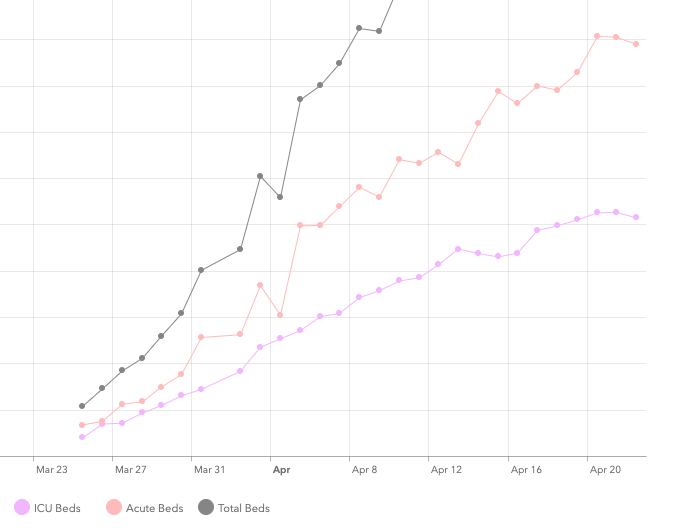There’s evidence that the United States has hit its peak in the spread of the coronavirus, and that rate of spread is slowing down.
We still have tens of thousands of new infections every day and thousands of new deaths. But at least it looks like the number of people infected is not accelerating.
On April 4, the U.S. added 34,000 new cases, according to the data website Worldometers. In every one of the 18 days since then, the number of new cases has been lower than 34,000. Since April 10, we’ve only had two days with more than 30,000 cases, and the most recent one was six days ago.
If left unchecked, a virus such as the novel coronavirus will spread exponentially. That is, if one person infects two people, and those two infect two each, and those four infect two each, you’ll see the number of cases not just grow, but accelerate. The graph of all cases will be shaped like a hockey stick.
That’s what happened throughout March. Since early April, though, the acceleration may have stopped. Instead of an exponential function, the chart of total people infected looks like a line with a steady slope upward.
Put another way, a daily graph of total new infections has plateaued.
The biggest caveat on case numbers is that this is all dependent on how much testing we do. It could be that the virus is still spreading at an exponential rate, but we’re just not testing enough people to catch it.
The death count is more concrete. We expect daily deaths to peak later than cases, and to drop off later, because time passes between diagnosis and death. Still, deaths per day have definitely flattened out.
Look at how rapidly the body count used to double back in late March. These are cumulative death totals (not daily death totals) from March 15 to March 29:
- Thirty dead to 73 dead in five days
- Seventy-three dead to 171 dead in three days
- One hundred seventy-one dead to 374 dead in three days
- Three hundred seventy-four dead to 957 dead in three days
So, at first, the death toll underwent a 30-fold increase in just two weeks back in March. Right now, the death toll has merely doubled in the last 11 days. This isn’t great news, but it’s vastly better than having death totals doubling (or worse) every three days.
In some ways, these numbers are too simplistic because they are nationwide. It may be more telling to consider that, in this country of 325 million people, the pandemic appears as a bunch of clusters of smaller outbreaks. The states hit earliest are also plateauing.
In my own state of Maryland, the number of intensive care beds occupied appears to have peaked and flattened.
Florida’s deaths and new cases appear to have peaked on April 6. Democratic New York Gov. Andrew Cuomo says that his state is already past its peak.
But other states? Michigan is generally seeing downward trends, but the more rural parts are seeing growth in the number of cases.
So tentatively, we can say that the rate of spread has slowed. In many places, hospitals are getting less crowded. We may have turned a corner.


